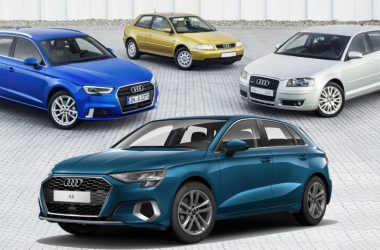A notchback car is a sedan or coupe with a squared-off roofline and distinct trunk. The term “notchback” refers to the rear side window shape, which resembles a notch or indentation in the otherwise continuous roofline. This differs from other body styles like hatchbacks which have angled rear windshields and no distinct trunk.
The origin of the notchback design dates back to the late 1930s, when Cadillac introduced the 1938 Sixty Special model with a unique roofline featuring a rear backlight or rear side window carved into the roof [1]. This allowed for increased headroom in the rear passenger compartment without raising the overall height of the car. The term “notchback” was later coined to describe this distinct rear roofline treatment.
In the early 1950s, American automakers began adopting the notchback design more widely. Nash introduced a notchback version of its Ambassador model for 1952, touting the roofline’s aerodynamic benefits [2]. The style grew in popularity through the 1950s and 60s as automakers continued refining the notchback shape. It allowed designers to combine the cargo space of a trunk with the accessibility of a sedan body.
Body Styles
A notchback car refers to a specific type of sedan body style with a trunk separated from the cabin by an indented notch or cutout in the rear of the roofline. This notch distinguishes it from other common sedan styles like the fastback and hatchback.
A sedan is a standard 4-door car with a separate trunk in the rear. Sedans have a variety of rear roofline styles including the notchback. The notchback has a distinct indent that separates the rear window from the trunk lid. This creates a notch-like appearance in the C-pillar, hence the name.
In a fastback sedan, the rear window connects to the bodywork of the trunk, creating a smoother, continuous line from roof to rear. There is no notch separating the rear window and trunk. Fastbacks tend to have a sportier, aerodynamic look compared to notchbacks.
Hatchback sedans have a rear door that opens upward to access a cargo area that is open to the passenger cabin. Instead of a notched roofline, hatchbacks have a more squared-off, upright roofline and rear profile. This allows for easy access to the cargo space.
By contrast, notchback trunks have a separate storage area isolated from the main cabin. The indented notchback shape provides a distinct visual separation between the passenger and cargo sections. This can create a more traditional 3-box sedan profile compared to fastbacks and hatchbacks.
Understanding the differences in these sedan body styles helps determine which best suits your needs for cargo capacity, aesthetics, and performance. Notchbacks offer a good balance of utility and style.
Design
A notchback design refers to a specific three-box configuration for automobile body styles. The primary feature of a notchback is its distinct notch or depression between the rear window and trunk. This creates a unique break in the continuous roofline, separating the rear passenger compartment from the trunk.
Unlike other body styles like sedans, hatchbacks and fastbacks, notchbacks have a distinct “notch” contour where the C pillar meets the trunk. This notch gives notchback vehicles a distinctive profile. The notch often features sharper angular lines versus the more rounded or sloped C pillars found on other body styles.
The three-box configuration of a notchback creates three distinct sections – the engine compartment, passenger compartment and trunk. This provides a balance of interior space, cargo capacity and attractive styling. The notch itself allows for a fuller trunk and cargo space versus a fastback.
Notchback designs emphasize the division between the passenger and cargo areas. This provides a visual distinction and profile unique to notchbacks within the range of automobile body styles. The notchback’s signature notch and three-box shape make its silhouette and rear view instantly recognizable.
Aerodynamics
The notchback design has several aerodynamic advantages over other body styles like hatchbacks and fastbacks. The abrupt cut-off at the rear creates less drag than a fastback slope, allowing notchbacks to achieve lower drag coefficients for better fuel efficiency at high speeds.
The notchback’s vertical rear profile also reduces rear lift compared to hatchback and wagon designs. Lift forces can reduce traction and stability at speed, so minimizing lift improves high-speed handling. Less lift also reduces fuel consumption.
In addition, the enclosed trunk of a notchback better manages airflow off the rear of the car compared to liftgate designs. This allows notchbacks to direct air more cleanly off the back to reduce turbulence and drag.
While notchbacks may not be as aerodynamically optimized as fastbacks, their aerodynamic properties offer performance advantages over upright sedan and wagon body styles. Automakers optimize notchback aerodynamics through careful shaping and detailing of the rear. Overall, the notchback shape provides a good blend of interior utility and aerodynamic performance.
Cargo Space
One key advantage of notchback car designs is increased cargo capacity in the trunk compared to other styles like coupes and hatchbacks. Notchbacks optimize cargo space due to their trunk opening and distinct three-box design with a separated trunk area.According to MotorTrend, notchbacks like the Toyota Corolla can offer nearly 50% more cargo volume behind the rear seats than hatchback counterparts. When the rear seats are folded down, the cargo capacity is often expanded even further in a notchback. For example, the Honda Civic sedan offers over 25 cubic feet of cargo volume with the rear seats folded, compared to under 23 cubic feet in the Civic hatchback. Overall, notchback sedans and coupes offer greater trunk space and cargo volume than other body styles.
Popular Models
Some of the most popular notchback models through the years have included:
– Toyota Corolla – One of the best-selling cars of all time, the Corolla sedan has had a notchback design since its debut in the 1960s and continues today.
– Honda Civic – Introduced in 1972, the Civic has been a popular compact sedan choice with a notchback design for most generations.
– Ford Taurus – This midsize sedan was extremely popular in the 1980s and 1990s and had a distinct notchback rear.
– Chevrolet Malibu – Chevy’s midsize sedan has utilized a notchback design since its first generation in 1964 through today.
– Volkswagen Jetta – The Jetta has been VW’s popular compact sedan since 1979, usually with a notchback design.
– Chevrolet Cruze – From 2011-2019, Chevy’s compact Cruze sedan had a popular notchback look before being discontinued.
– Tesla Model 3 – The all-electric Model 3 is currently among the top selling sedans with its distinct notchback design.
Safety
Notchback cars generally provide good safety for occupants compared to other body styles. Their enclosed trunk area helps protect passengers in the event of a rear-end collision (http://www.citroenet.org.uk/foreign/china/fukang/c-quatre.html). Many notchbacks utilize safety features like crumple zones, side impact beams, and airbags to absorb impact and protect occupants.
Notchbacks tend to have a lower rollover risk than taller vehicles with higher centers of gravity, like SUVs and trucks. Their lower ride height and wide stance enhance stability and handling. However, hatchbacks and sedans usually match or exceed the rollover safety of notchbacks.
In crash tests by the National Highway Traffic Safety Administration (NHTSA) and the Insurance Institute for Highway Safety (IIHS), popular notchback models like the Honda Accord, Toyota Camry, and Subaru Legacy earn top ratings for protecting occupants in various collision types (https://www.newspapers.com/newspage/48546602/). Their combination of safety features and structural design aim to minimize injury risks.
While notchbacks offer good occupant protection, their safety ultimately depends on numerous factors like vehicle size, structural rigidity, airbag placement, and advanced driver aids. Consumers should compare ratings from NHTSA and IIHS when evaluating notchback safety.
Cost
Notchbacks tend to be more affordable than other body styles like coupes or convertibles. According to LS1Tech forums, converting a sedan to a notchback can cost between $500-800 for the custom work. The parts themselves like the intake, headers, and transmission crossmember can add another $1000 or so to the project.
In 2021, the average starting MSRP for a notchback was around $22,000 while the average coupe started around $27,000. Coupes sacrifice interior space for sportier styling which is reflected in the higher cost. Notchbacks provide more cargo room and seating capacity making them a practical and affordable option.
Maintenance
Notchback cars do not require extensive additional maintenance compared to other body styles. However, there are a few considerations to keep in mind:
Accessing the engine bay – The notchback design can make it slightly more difficult to access the engine bay for routine maintenance like oil changes and tune-ups. Mechanics may need to remove interior trim pieces or drop the rear seat to improve access.
Rust prevention – The seam where the roofline meets the rear window is prone to rust on notchbacks. It’s important to keep the drain holes clear and touch up any paint chips in this area to prevent corrosion.
Glass care – The wraparound rear window is larger on a notchback and may be more expensive to replace if damaged. Use caution when cleaning the glass to avoid scratches.
Overall, following the manufacturer’s maintenance schedule and addressing any issues promptly can help maximize the lifespan of a notchback. Pay special attention to potential rust areas and engine access when servicing the vehicle.
Conclusion
In summary, the notchback design offers some key advantages and disadvantages compared to other car body styles. On the plus side, notchbacks tend to have improved aerodynamics and fuel efficiency compared to traditional sedans. They also provide more usable cargo room while maintaining a sleek, stylish profile. However, some downsides are that visibility can be reduced, certain models may have less rear seat headroom, and resale value may not be as high as other styles. Overall, notchbacks appeal most to buyers who prioritize sporty styling and driving dynamics while still needing practicality of 4 doors and trunk space. Though they are not as ubiquitous as regular sedans, they continue to have a loyal following among driving enthusiasts.
Looking ahead, it seems the notchback body style may decline further in popularity as buyer preferences shift to SUVs and crossovers. However, among sedan buyers there remains an appeal for the distinctive profile and performance that notchbacks can provide. As long as a market exists for sporty yet practical sedans, the notchback is likely to endure as a unique offering within the automotive landscape.





